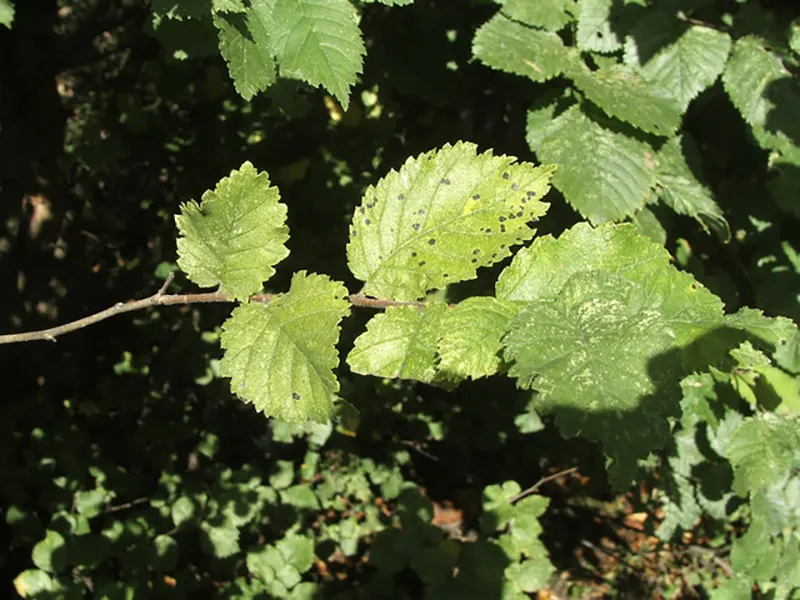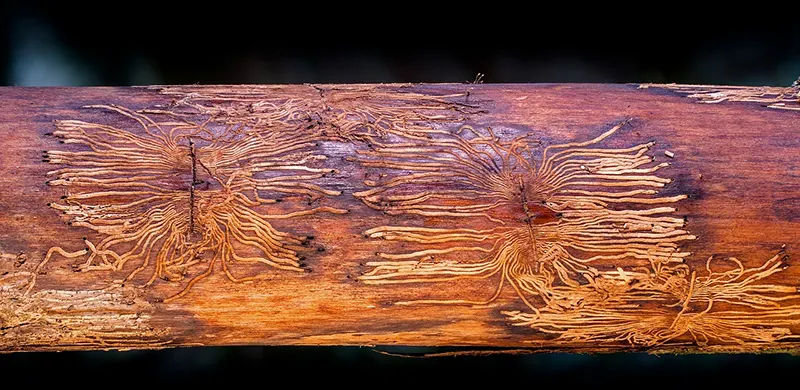What is Dutch Elm Disease?
Dutch elm disease is a fungal infection caused by the elm bark beetle. The scientific names of the fungi that cause this disease are Ophiostoma ulmi and Ophiostoma novo-ulmi.
Why Dutch elm disease?
It’s called Dutch elm disease, as it was first identified in 1921 in the Netherlands, but it’s believed to be Asian in origin. Since then, it has spread around the world and affects many elm species.
Let’s look at this disease a little more closely.
Image courtesy of 4.0 International
Symptoms to Look For
The earliest symptom that you’ll find is yellowing or wilting of the leaves in one section of the crown, usually during spring or early summer. The leaves will quickly turn brown and fall off, so look for leaves lying on the ground.
Lots of things cause leaves to turn yellow – how can I be sure it’s Dutch Elm Disease?
Cut off a twig from the part of the crown where the leaves have died. Carefully peel back the bark and look at the wood. If you see brown discoloured circles or dots on the xylem or sapwood, it’s a good indication that the tree has DED.
These marks indicate that the flow of sap through the xylem has been stopped by the fungal infection, which has caused the leaves to wither and die.
How Does the Virus Get Into My Tree?
There are two methods of spreading this fungus.
Dutch Elm Beetles
The first is via the Dutch elm beetle. There are two main species of beetle; the European elm bark beetle (Scolytus multistriatus) and the American elm bark beetle (Hylurgopinus rufipes).
To explain how this happens, let’s look at the beetle’s life cycle.
- An elm tree that is infected with the fungus dies.
- The fungus’s sticky conidia (spores) remains active within the wood of the dead tree.
- The female elm beetle bores her way into the deadwood, feeding as she goes, and lays her eggs in the tunnel.
- The eggs hatch into larva, and they bore their own tunnels, feeding on the wood. These tunnels are at right angles to the maternal tunnel. The resulting “gallery” protects the larva until they pupate.
- The larva pupate and move through the tunnels to emerge into the world as adult beetles.
- As the adult beetles make their way through the tunnels, the sticky conidia adhere to the beetles, and they carry the spores into the open.
- The female beetles feed on living elm trees, boring through the softer crotch between twigs.
- As they bore into the elm, they deposit the spores into the healthy elm tree, and the cycle begins again. The fungus infects the xylem, and the tree reacts to this invasion by plugging the xylem with a gummy substance. Eventually, this stops the transport of water and nutrients to the branches. As the fungal infection spreads, more of the tree will die.
Root Grafts Between Neighbouring Trees
The second, unrelated way the fungus can spread is via the roots of an infected tree where elm trees are growing close to one another. The roots of one tree naturally graft onto the roots of a neighbouring tree. If this happens, the fungus can move from one tree to another.
Image courtesy of 4.0 International
Can I Stop the Spread?
There are only two ways to stop this fungus. The first is cutting out the infected tree and burning or burying the wood, so it is not accessible to the female elm tree beetle for egg-laying.
The second is a combination of pruning the infected branches, dealing with the wood as detailed above, and applying a systemic fungicide that is taken up by the roots and distributed through the tree. In important trees, fungicide is ”injected” by drilling holes into the trunk and pumping fungicide into the tree.
Can My Bonsai be Affected?
In theory, any elm tree is susceptible, but it’s improbable that the elm tree beetle would detect such a small tree.
In Europe, elm saplings are often ignored by the beetle until they reach a specific size, then the beetle will cause infection.
The most common elm used in bonsai is the Chinese elm (Ulmus parvifolia) which is naturally resistant to Dutch elm disease, which is helpful. Many hybrid elms are available, which, if their rootstock is the Chinese elm, will also carry this natural resistance.
The American elm Ulmus americana is highly susceptible to the fungus, as is the English Elm (Ulmus procera), Wych elm (Ulmus glabra), and smooth-leaved or field elm (Ulmus carpinifolia or Ulmus minor). The Wych Elm is the least susceptible to DED of the European elm trees.
Where is Dutch Elm Disease Found?
Dutch elm disease is pretty widespread. It can be found all over the British Isles and is common in North America, Continental Europe, Central Asia, and New Zealand.
Final Thoughts
As all elms are susceptible to Dutch Elm Disease, you bonsai elms could be infected. However, as we have already said, it is improbable that the elm beetles will find these small trees worth pursuing.
However, if you have large elms growing close by, it would be a good idea to keep a close eye on your little trees. Any loss of condition should be investigated immediately, and if you suspect elm beetles check the twigs and take remedial action.






